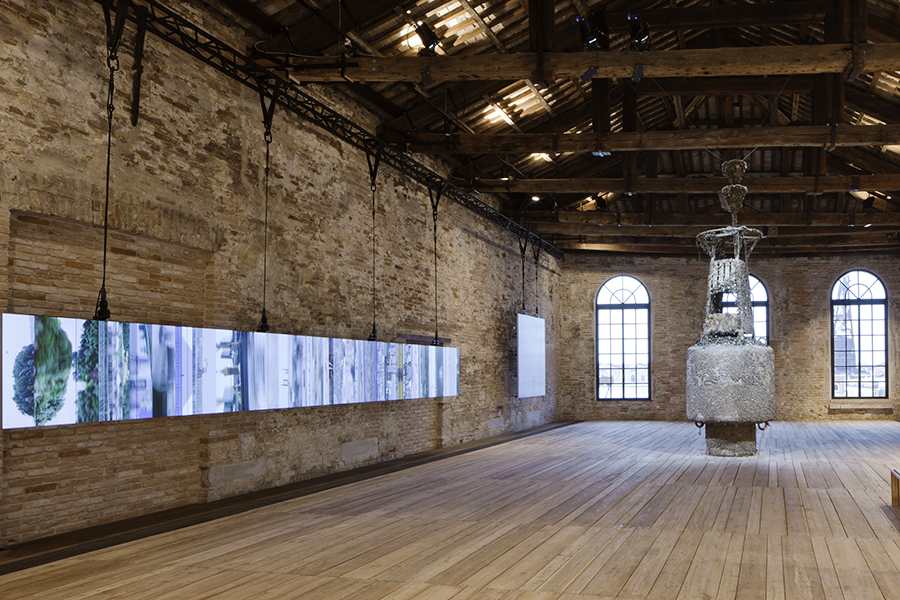Shows
Singapore Pavilion at the 56th Venice Biennale: Sea State


What is at stake when the abstract becomes real and concrete? This question is posed in the works included in “SEA STATE,” Charles Lim’s contribution for the Singapore Pavilion at the 56th Venice Biennale, and also the culmination of a research project that the artist and filmmaker has been working on for the past ten years. Lim’s multimedia project takes as its focal point the sea—to expunge some of the myths of its infinite expanse. Here, the sea is treated as a mapped resource, an abstract commodity, and an entity through which strategic nation-building, as well as economical and political pursuits, are built.
In Lim’s SEA STATE project, the interconnected logics of government and capitalist expansion unravel themselves through the material transformation of natural spaces. These are landscapes of “real abstraction,” in which the universal logics of capital—and their abstract social forms (such as value, commodity-exchange, money)—are extruded onto geography. In the single-channel video SEA STATE 6: phase 1 (2015), Lim takes the viewer down the Jurong Rock Caverns in Singapore, a recently-launched, massive underground infrastructure for oil and fuel storage, built to support the commercial operations of oil traders, petrochemical ventures and manufacturing industries in the area. Viewers are guided down a still-empty cavern, where there is ongoing construction and workers toil away to the comforting melody of a Malay song that resounds throughout the cave.The force from an administered, explosive charge reverberates across the tunnel, but makes no impact aboveground. The stones above remain unmoved and a sand-carrier ship sails on, while streaks of oil coat the surface of the sea. These are the ordinarily invisible workings involved in the manufacturing of a space willed into existence by the abstractions of economic interests, bound as they are to the politics of national sovereignty. Perhaps the reification of abstract calculations into concrete movements was best articulated by Lui Pao Chuen, the former Chief Defense Scientist of Singapore’s Ministry of Defense for 22 years, in an interview published in the exhibition catalogue. “It is only a SGD 5 billion project. Why? Because SGD 5 billion is how much the integrated resorts costed,” Lui notes. “If one can spend SGD 5 billion for gambling, surely you can put SGD 5 billion for the caverns.”


That our geological landscape is altered by man is no late-capitalist revelation. Lim takes the notion of the sea (and land)—as Karl Marx did with the commodity—to make visible the concrete and abstract processes of capital flow. Yet these processes are not simply concrete or abstract; rather, one is appropriated into the other—where the abstract processes of capital flow are concrete and operative in the lived present. Lim’s geological landscapes are not just ones that adhere to the spatialization of capitalism; they are marked by what social theorist Alberto Toscano described as an “indifference of concrete abstraction”—phenomenal for their ubiquity, scale and undaunted iterations. As Lim reminds us, in the case of the Jurong Rock Caverns, this is just phase 1.
In some ways, phase 1 is in conversation with the works of the late American photographer Allan Sekula, whose engagement with maritime space focused on the anonymity, isolation and persistence of its workers. Yet, Lim’s concern for the “hiddenness” of manual labor, both in reality and within social consciousness, translates less into labor’s political representation than depicting labor as it is, in the abstract, and opens onto a somewhat different critical terrain from Sekula’s. Strikingly, if the displacement of manual labor from social imagination is exacerbated by what Sekula called photography’s “imaginary temporal and geographical mobility,” this is precisely what Lim undertakes in the video work SEA STATE 7: sandwich (2015), as if to turn our attention from the histories of labor representation in documentary practices to the infrastructure of labor. Sandwich presents a horizon of land reclamation sites, industrial infrastructures, container ships and a commodified beach, each an individual scene that are laid out vertically and placed side-to-side and further “diagrammed” by the grid-like display of panoramic screens on which they are shown. Sea and worker are “cut off,” or minimized, as if the splicing together of their infrastructural, instrumental and operational elements was the only way to accurately portray both the sea and the site of its politics in a way that is adequate to our current moment.
It is worth noting that the diagrammatic grid is made a condition of viewing in many of Lim’s works—from phase 1, sandwich to SEA STATE 2: as evil disappears (2012), with the latter comprising two prepared charts that reveal the disappearance of the island Pulau Sajahat from maps to be as a result of land reclamation. It is as if both the sea and its abstractions obtain an imageability through the grid, across the page and the screen. If it recalls something of the modernist grid, for Lim this is never simply a visual system of modernist rationality and its expansions towards the infinite, as Singapore Pavilion curator Shabbir Hussain Mustafa points out in the exhibition catalogue. Rather, what becomes of the act of looking, in our current political moment of total surveillance, seems best described in the strange, stand-alone island seen in SEA STATE 9: proclamation (2015), cut and pieced together from maps of Singapore’s reclaimed lands. Looking is not just subject to contortions and mediations—it also produces them.

Charles Lim’s “SEA STATE” for the Singapore Pavilion at the Venice Biennale is on view until November 22, 2015.







